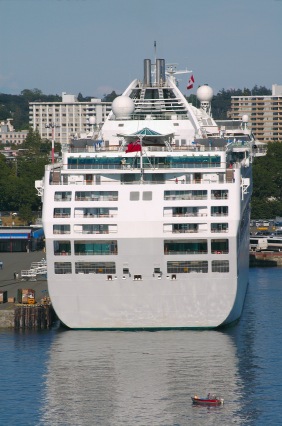
Cruise ship tourists milling about the streets of Victoria are more likely to encounter inviting smiles than frowns. But many residents worry about air pollution from the big vessels -- and a newly available study appears to confirm those fears, tripling the previous official estimate of local toxic sulphur dioxide emissions.
Over the past decade, the number of cruise visits has grown from none to more than 200 a year. On some summer days, five of the giant vessels pull up, each unloading thousands of passengers for a few hours of bus tours and horse carriage rides.
In a city where tourism is a major pillar of the economy, everyone from the city council to the Chamber of Commerce has welcomed the visits -- and the bulk of news coverage has focussed on the number of dollars being left in the city rather than on any negative impacts.
But an angrier response to the trend can be glimpsed on the Greater Victoria Harbour Authority's website where a community member complains about air quality near the city's cruise ship docks.
"The inaction by the GVHA to provide an effective solution to stopping cruise ship emissions being pumped into the residential areas of James Bay can be best described as criminal neglect," he wrote. "Eventually, we will reach the point of demanding compensation from the GVHA for its unwillingness to resolve this ongoing act of environmental terrorism being impacted upon our community."
On the website, a GVHA official responds by pointing to the James Bay Air Quality Study (JBAQS), a report that was ordered to appease the cruise industry's few naysayers -- most of whom live in James Bay homes a few hundred metres from the Ogden Point docks.
That 153-page 2008 report, based on 2007 research, was done for the Vancouver Island Health Authority and bears the logos of the GVHA, the University of Victoria, the province of British Columbia and various environmental consulting companies. While levels of some pollutants went up when cruise ships were present, the levels were well within provincial guidelines, it found.
Nothing to worry about, it essentially said -- and for some time that was the last word on the subject, muting calls for slowed cruise visit growth and measures to reduce air pollution.
Human health risk
But the authors of a newly available air quality report from Nov. 2009 -- based on data from 2008 and just posted to the Capital Regional District's website -- found that VIHA's study had grossly underestimated the pollutants that cruise ships spew out around Victoria.
"SO2 [sulfur dioxide] concentrations in the vicinity of Ogden Point may be much higher than was estimated in the JBAQS, and may be high enough in the James Bay community to be of concern for human health impacts in that area," wrote the authors of the Air Quality in the Capital Regional District report.
The James Bay study appears to have underestimated by a factor of three the amount of sulphur dioxide emitted by cruise ships, they found.
Even at relatively low levels, the gas harms plants. In higher concentrations, it can make it harder to breathe for people with respiratory diseases like asthma or bronchitas.
Measurements for both studies were made at the Topaz site on the opposite side of downtown, several kilometres from Ogden Point. The James Bay study estimated that the sulphur dioxide concentrations at Ogden Point would be five times as high as what was measured at Topaz.
If that holds true, the CRD report authors wrote, it would put the concentration at Ogden Point above certain B.C. and World Health Organization (WHO) guidelines. "This concentration would exceed the BC Level A ambient air quality objective of 450 μg/m3 [micrograms per cubic metre], and would also exceed the WHO 10-minute average guideline level of 500 μg/m3," they wrote.
Cruise ship visits were also associated with elevated levels of nitrous gases and particulate matter, the report said.
Some ships worse than others
Sulphur dioxide is released when fuels containing sulphur are burned, the report explained. There have been efforts to lower the amount of sulphur in gasoline and in diesel used in road vehicles. As a result, emissions have declined considerably in the last ten years, it said. "A similar sulphur reduction initiative for marine fuels may occur in the near future."
But such a reduction is yet to occur. Spikes in sulphur dioxide measured across downtown at the Topaz site correspond with cruise ship visits, they write. "It is immediately obvious that... SO2 concentrations measured at the Victoria Topaz site are generally higher when cruise ships are docked at Ogden Point than when there are no cruise ships in the harbour."
The highest one hour average concentration that they measured -- a level of 146 μg/m3 -- was at a time when cruise ships were present. That level was three times as high as the highest measurement made when no cruise ships were in the harbour.
The report even shows which ships are the likely culprits. While some vessels make regular visits without causing a spike, others appear to make the levels jump.
Sulphur dioxide levels were elevated during five of the Golden Princess' 18 visits and during eight of the 20 visits by its sister ship the Star Princess. Levels of the gas went up during five of the 23 visits of the Oosterdam and during six of the 21 from the Westerdam. And during six of the Norwegian Pearl's visits the levels also went up.
With the evidence now confirming what critics have said for years, the true test will be based on how the cruise industry and its many supporters in the city respond.
In the meantime, the GVHA is advertising a position for an environmental researcher. The person will report to the authority's manager of communications, according to an ad in Victoria's daily paper Saturday. ![]()
Read more: Environment















Tyee Commenting Guidelines
Comments that violate guidelines risk being deleted, and violations may result in a temporary or permanent user ban. Maintain the spirit of good conversation to stay in the discussion.
*Please note The Tyee is not a forum for spreading misinformation about COVID-19, denying its existence or minimizing its risk to public health.
Do:
Do not: